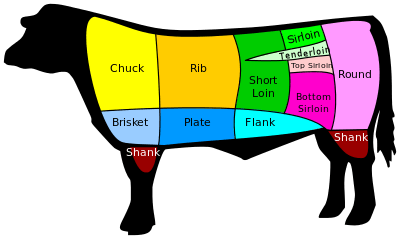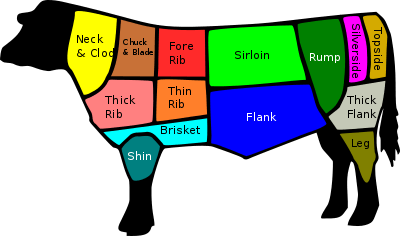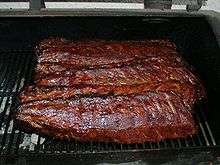Spare ribs
Spare ribs (also side ribs or spareribs) are a variety of pork ribs cooked and eaten in various cuisines around the world. They are cut from the lower portion of the pig specifically the belly and breastbone, behind the shoulder, and include 11 to 13 long bones. There is a covering of meat on top of the bones and also between them. Spare ribs (pork) are distinguished from short ribs, which are beef.
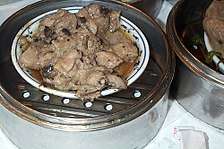
A bowl of steamed paigu with fermented beans, a spare rib dish commonly eaten in dim sum
Terminology
- Pork spare ribs are also popular in Chinese and American Chinese cuisine; they are generally called paigu (Chinese: 排骨; pinyin: páigǔ, Cantonese: paigwat; literally "row of bones").
- In County Cork, Ireland, pork or beef spare ribs are boiled and eaten with potatoes and turnips. This dish is called bodice locally.
Preparation
In Chinese cuisines
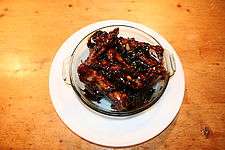
Chinese spare ribs
- In Chinese cuisine, pork spare ribs are generally first cut into 7-to-10-centimetre (3 to 4 in) sections, then may be fried, steamed, or braised.
- In the Cantonese cuisine of southern China, spare ribs are generally red in color and roasted with a sweet and savory sauce. This variety of spare ribs is grouped as one of the most common items of siu mei, or Cantonese roasted meat dishes.
- In American Chinese cuisine, pork spare ribs are generally cooked in char siu style, and often feature as a part of the appetizer dish called pu pu platter.
In American South cuisine
Spare ribs have also become popular in the American South. They are generally cooked on a barbecue or on an open fire, and are served as a slab (bones and all) with a sauce. American butchers prepare two cuts:
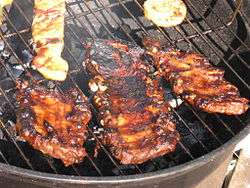
Basted spare ribs on an outdoor grill
- Pork spare ribs are taken from the belly side of the pig's rib cage above the sternum (breast bone) and below the back ribs which extend about 6" down from the spine. Spare ribs are flatter than the curved back ribs and contain more bone than meat. There is also quite a bit of fat which can make the ribs more tender than baby back ribs.
- St. Louis Cut ribs are spare ribs where the sternum bone, cartilage, and the surrounding meat known as the rib tips have been removed. St. Louis Cut rib racks are almost rectangular.
- Beef short ribs are taken from the belly side of the cattle's rib cage above the sternum (breast bone). Beef spare ribs tend to be longer, wider, and sometimes more curved than their pork counterparts, and are cut from the prime rib rump, of which the thicker boneless part becomes the ribeye steak, and the upper tips of the ribs are then cut off and become short ribs.
Consumption
Spare ribs are usually consumed individually by hand, with the small amount of meat adhering to the bone gnawed off by the eater.
See also
- Beef ribs
- Char siu
- Pork ribs
- Prime ribs
- Pu pu platter
- Ribs (food)
- Short ribs
- Soki
References
This article is issued from Wikipedia. The text is licensed under Creative Commons - Attribution - Sharealike. Additional terms may apply for the media files.
